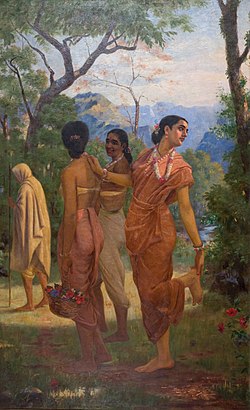| Shakuntala | |
|---|---|
| Shakuntala looking for Dushyanta. | |
 | |
| Artist |
Raja Ravi Varma
|
| Year | 1898 |
| Subject | Shakuntala and her friends |
| Dimensions | 110 cm (43 in) × 181 cm (71 in) |
| Location | Sree Chitra Art Gallery |
Shakuntala or Shakuntala looking for Dushyanta is an 1898 epic painting by Indian painter Raja Ravi Varma.
Ravi Varma depicts Shakuntala, an important character of Mahabharata, pretending to remove a thorn from her foot, while actually looking for her husband/lover, Dushyantha, while her friends tease her and call her bluff.
Tapati Guha-Thakurta, an art historian, wrote;
[T]his very gesture – the twist and turn of head and body – draws the viewer into the narrative, inviting one to place this scene within an imagined sequence of images and events. On its own, the painting stands like a frozen tableau (like a still from a moving film), plucked out of an on-running spectacle of episodes. These paintings also reflect the centrality of the "male gaze" in defining the feminine image. Though absent from the pictorial frame, the male lover forms a pivotal point of reference, his gaze transfixes Shakuntala, as also Damayanti, into "desired" images, casting them as lyrical and sensual ideals. [1]
References
- ^ Karline McLain (2009). India's Immortal Comic Books: Gods, Kings, and Other Heroes. Indiana University Press. p. 69. ISBN 9780253220523.
| Shakuntala | |
|---|---|
| Shakuntala looking for Dushyanta. | |
 | |
| Artist |
Raja Ravi Varma
|
| Year | 1898 |
| Subject | Shakuntala and her friends |
| Dimensions | 110 cm (43 in) × 181 cm (71 in) |
| Location | Sree Chitra Art Gallery |
Shakuntala or Shakuntala looking for Dushyanta is an 1898 epic painting by Indian painter Raja Ravi Varma.
Ravi Varma depicts Shakuntala, an important character of Mahabharata, pretending to remove a thorn from her foot, while actually looking for her husband/lover, Dushyantha, while her friends tease her and call her bluff.
Tapati Guha-Thakurta, an art historian, wrote;
[T]his very gesture – the twist and turn of head and body – draws the viewer into the narrative, inviting one to place this scene within an imagined sequence of images and events. On its own, the painting stands like a frozen tableau (like a still from a moving film), plucked out of an on-running spectacle of episodes. These paintings also reflect the centrality of the "male gaze" in defining the feminine image. Though absent from the pictorial frame, the male lover forms a pivotal point of reference, his gaze transfixes Shakuntala, as also Damayanti, into "desired" images, casting them as lyrical and sensual ideals. [1]
References
- ^ Karline McLain (2009). India's Immortal Comic Books: Gods, Kings, and Other Heroes. Indiana University Press. p. 69. ISBN 9780253220523.